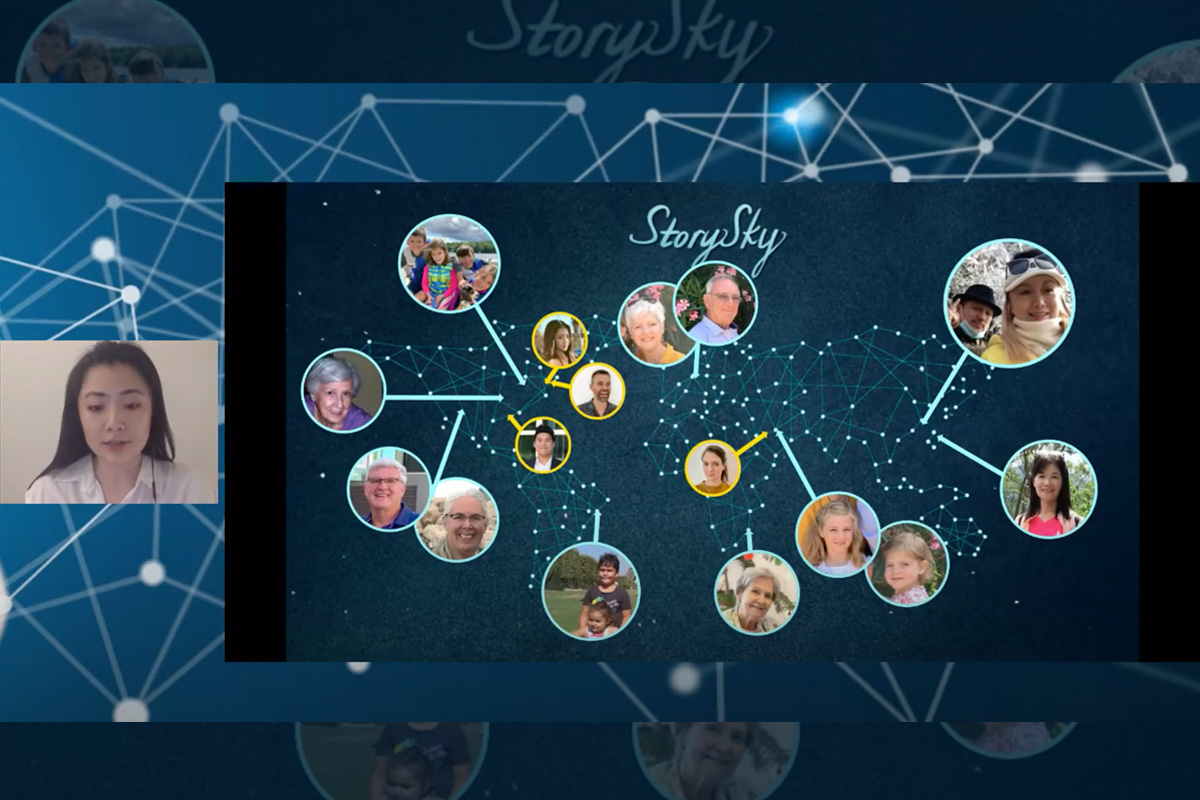When first-year students David Zikovitz (Instructional Technology & Media), Ying-Chen Lin (Instructional Technology & Media), Mulan Fu (Design & Development of Digital Games) and Marina Lemee (Computing in Education) teamed up to enter Teachers College’s 2020 EdTech Innovation Award (INA) Showcase, they had only a vague idea about creating some kind of online socialization app for children.
Then it hit them that they shared a common problem: In an unprecedented time of social distancing, their families were flung across five continents, 11 countries and 20 time zones.
The result became the Showcase’s winning entry: StorySky, an app that couples technology with story-telling to connect children and grandparents separated by the pandemic.
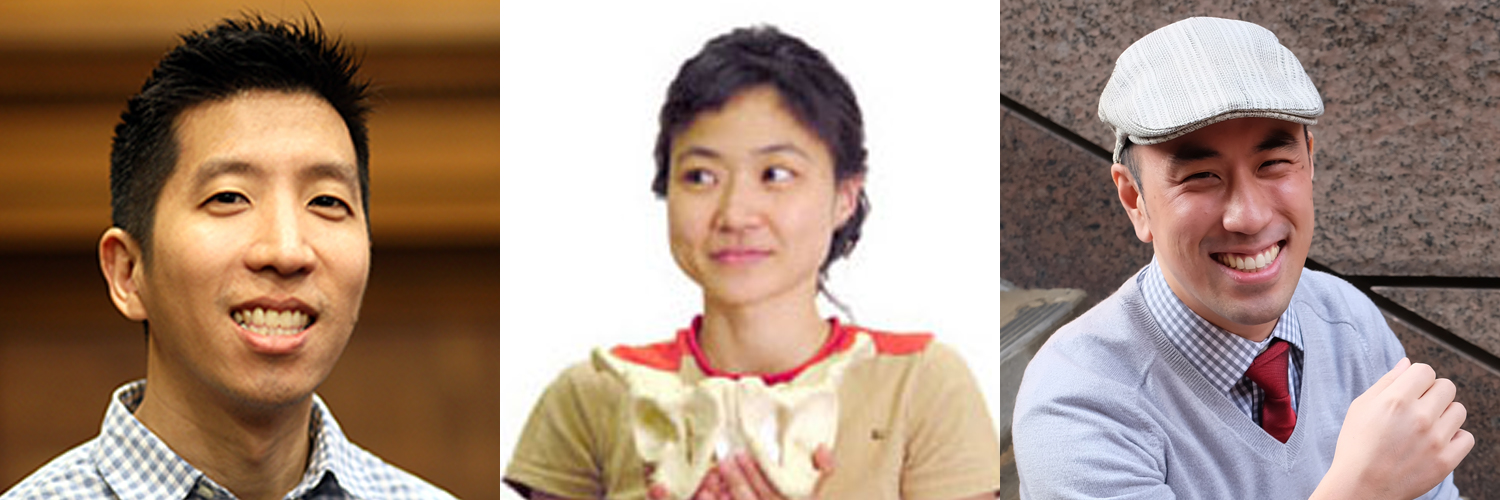
THE ORGANIZERS The INA Showcase’s guiding spirits are, from left, Joey Lee, Yoo Kyung Chang and Jin Kuwata. All three are faculty members in TC’s program in Communications, Media and Learning Technologies Design.
The projects created by the StorySky team and seven others powerfully reflected the 2020 INA design competition theme: “Life After COVID.”
[Watch the full 2020 INA Showcase and Pitch Competition.]
“The submissions addressed problems that we’ve faced during the pandemic, such as social isolation and the need to improve learning during these challenging times through connectedness and collaboration,” says Joey Lee, INA co-coordinator along with fellow Communication, Media & Learning Technologies Design program (CMLTD) faculty members Yoo Kyung Chang and Jin Kuwata.
The submissions addressed problems that we’ve faced during the pandemic, such as social isolation and the need to improve learning during these challenging times through connectedness and collaboration.
—Joey Lee, INA co-coordinator
The INA program was launched in 2017 and made a big splash when the developers of that year’s winning entry — BestFit, a decision-making tool to help high school students identify colleges that can provide them with the support and environment they need to succeed — subsequently won additional competitions and ended up taking their product to market. [Read a story about BestFit and its creators, Asha Owens (M.A. ’18, Instructional Technology & Media) and Rebecca Kwee (M.A. ’18), Higher & Postsecondary Education).]
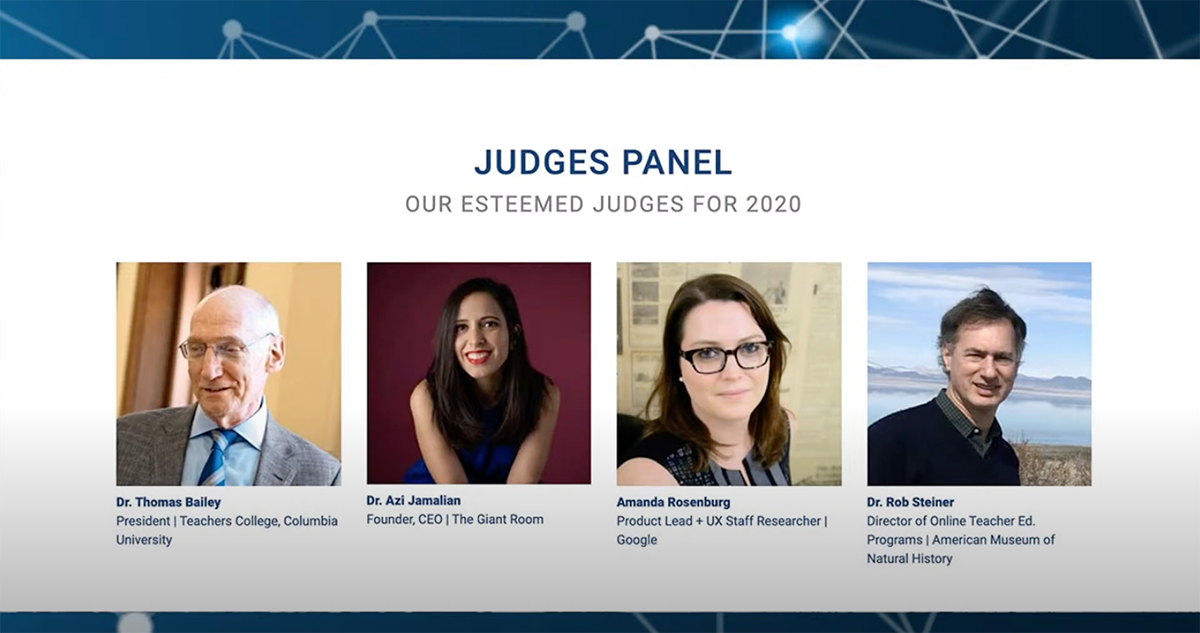
THE ARBITERS The INA judges, drawn from industry and academia, provided feedback and mentoring.
“INA is a wonderful program because it promotes interdisciplinary collaboration in the process of designing research-based solutions,” Lee says. “It mobilizes students who are passionate about design and it also brings in students from other disciplines. And while other schools have incubator programs that incorporate entrepreneurship and design, I haven’t really seen anything else like this — a design thinking program that combines those elements with a focus on EdTech research.”
But INA isn’t just a competition — it’s also a scaffolded learning experience that includes an eight-week training program in which each team is tasked with exploring practical applications, potential beneficiaries and uses for their projects. The participants learn skills in research, project management and user experience, and user-centered design, and receive feedback and mentoring from judges drawn from industry and academia. This year’s judging team consisted of Azi Jamalian (Ph.D. ’14), Founder and CEO of The Giant Room and Co-Founder and former Chief Learning Officer of Tiggly; Robert Steiner, Director of Online Teaching Programs at the American Museum of Natural History and Adjunct Assistant Professor in TC’s Department of Mathematics, Science & Technology; Amanda Rosenburg, a Lead Product Design and UX Researcher at Google; Detra Price-Dennis, TC Associate Professor of Education; Sandra Okita, TC Associate Professor of Technology & Education; and TC President Thomas Bailey, who all provided feedback and mentoring.
“EdTech is often disconnected from the people doing the actual development and design,” says Lee. “Designers finish a project before asking an EdTech person for advice or a stamp of approval. That is backwards, and it’s a major reason why so much EdTech is poorly designed.”

THE WINNERS The StorySky teammembers realized they had one thing in common: family members scattered across the globe.
This year’s projects, perhaps more than in other years, reflected a confluence of educational technology, research and personal experience.
Sometimes there was significant overlap between the latter two categories.
For example, StorySky – so named because it enables users to create “constellations” of digital story-telling, photos and video — was vetted with and fine-tuned in response to a particularly tough audience.
We had a lot of grandparent tests — and a lot of frustrated grandparent stories. But we made it as streamlined as possible and got them through it by helping them understand what a prototype is.
—Marina Lemee, StorySky team member
“We had a lot of grandparent tests — and a lot of frustrated grandparent stories,” says Marina Lemee, eliciting knowing laughs from teammates. “But we made it as streamlined as possible and got them through it by helping them understand what a prototype is.”
The result is a tool that can be used every member of the family and even friends. “The stories can be collaborative and extended or a short anecdote from the memory of a single family member or a series of different perspectives on the same event,” says StorySky team member David Zikovitz.
“StorySky has great potential for preserving family history in a particularly elegant manner,” says Robert Steiner of AMNH.
The project that won this year’s INA “People’s Choice” award — Musitation, a virtual reality app that, like Apple’s Garage Band, allows users to compose and create, but incorporates greater collaboration and social interaction — was also inspired by a desire to bring people together.
I was used to being surrounded by people who love singing and music.Then COVID hit and we could no longer meet in person, and I lost the routine of practicing together. It’s so hard, because you just don’t have the same motivation singing alone in your room. You’re missing the social component and the connection with the like-minded.
—Fei Wang, Musitation team member
“I was used to being surrounded by people who love singing and music,” says Musitation team member Fei Wang, a second-year student in the Instructional Technology & Media program. “Then COVID hit and we could no longer meet in person, and I lost the routine of practicing together. It’s so hard, because you just don’t have the same motivation singing alone in your room. You’re missing the social component and the connection with the like-minded.”
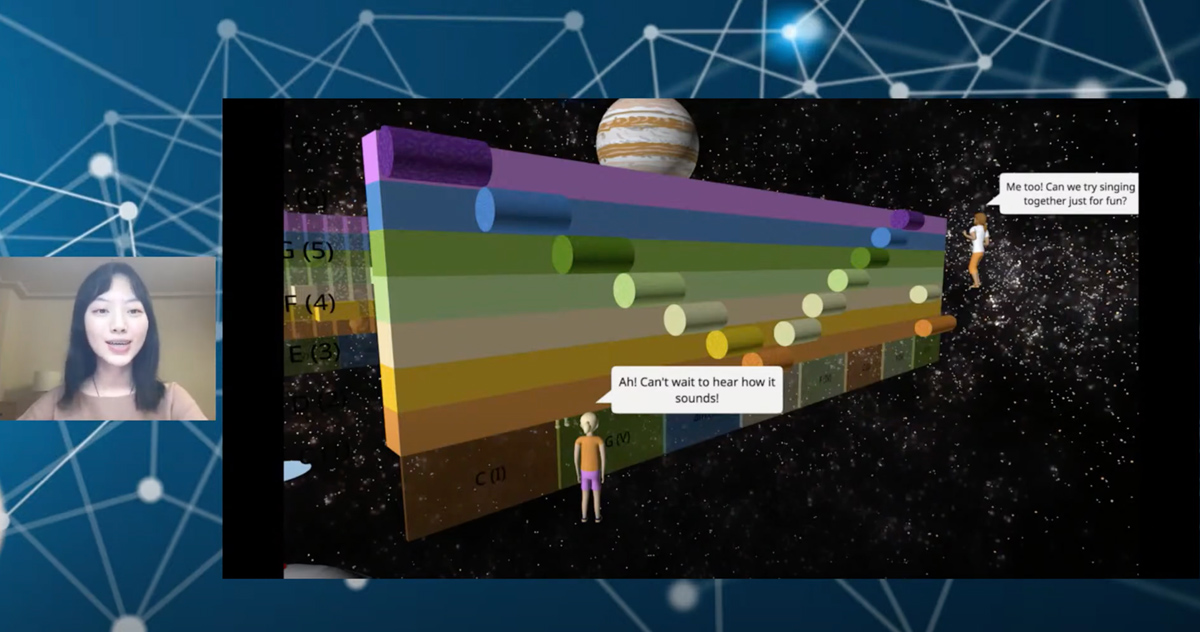
THE PEOPLE'S CHOICE An app called Musitation, which enables musicians to compose and play together, won the INA People‘s Choice award. At left, Musitation team member Fei Wang.
As the pandemic extended into the fall semester, Wang began thinking about an immersive, interactive online composition and performance application to connect quarantined musicians. She pitched the idea to INA participants at a late September informational session. By the end of the meeting, students Daniel Ahn (Mathematics, Science & Technology), Anh-Thu Phan (Music & Music Education), Calley Nelson (Spirituality, Mind & Body) and Jason Reid (Psychology in Education) had joined the Musitation team.
“Musitation is a way to connect with people who are also interested in creating music in a gamified, fun and low-pressure environment,” enthuses Nelson. “The low bar to entry means that a professional musician and a beginner with no prior music experience can create music together and have a good time.”
Google’s Amanda Rosenburg puts it more simply, saluting Musitation, for “making music tangible.”
Another interesting sidelight: Because of COVID, the 2020 INA participants, with a few exceptions, have never met one another in person, collaborating instead through venues such as Slack, Zoom or Google Hangout.
The whole thing has been super surreal because of the pandemic. We did this whole creative process, we won the competition — and I’ve never left this chair.
—David Zikovitz, StorySky team member
“The whole thing has been super surreal because of the pandemic,” David Zikovitz says. “We did this whole creative process, we won the competition — and I’ve never left this chair.”
Still, Lee says the caliber of the 2020 projects has prompted discussion of keeping INA online in the future. Doing so, he explained, would open the participation to students from not only New York City schools but colleges and universities across the United States and around the globe.
“In a sense, this was a test run that showed us that an online format might help the INA program to become more scalable for us,” Lee says. “Ultimately, we hope to grow it into something really big, with funding streams, and perhaps with additional workshops, courses or certificates related to it. We hope to broaden INA to be similar to other incubator programs where it can provide seed funding and generate revenue, while providing mentoring, feedback, meaningful connections and project-based learning opportunities as central goals.”
This was a test run that showed us that an online format might help the INA program to become more scalable for us. Ultimately, we hope to grow it into something really big...where it can provide seed funding and generate revenue, while providing mentoring, feedback, meaningful connections and project-based learning opportunities as central goals.
—Joey Lee, INA co-coordinator
Not every team is going to take its idea to market, he adds — and that’s fine. “If the INA experience and skills students learn through the process translate to other areas of their lives and help prepare them for their professional careers, that’s just fine.” Still, Lee says, “I think students were successful in developing creative, innovative learning solutions — beyond Zoom — to address the challenges faced during the global pandemic.”
—Steve Giegerich
BestFit Gets Even Better: the 2017 INA Winner is Making It in the Market
The INA Showcase’s standard for practical application was established by BestFit, the winning entry of the inaugural Showcase in 2017.
Created by TC alumnae Asha Owens (M.A. ’18, Instructional Technology & Media), who is now BestFit’s Chief Executive Officer and Rebecca Kwee (M.A. ’18, Higher & Postsecondary Education), now the company’s Chief Operating Officer, the BestFit platform matches high school students on the cusp of becoming first in their family to attend college with first generation-college students able to answer their questions about academics and campus life. (A third collaborator in creating BestFit, Danielle Llaneza (M.A. ’18, Developmental Psychology), is now a UHAND Graduate Scholar at MD Anderson Cancer Center and Adjunct Lecturer at Hunter College.)
For us, as women of color pursuing STEM degrees, there were a lot of challenges we faced. And when we looked at the higher-ed ecosystem, [we found that] 75 percent of low-income minority students who enroll in college won’t graduate. That’s what we’re determined to change.
—BestFit co-founder and CEO Asha Owens (M.A. '18), from an article in hypepotamus.
“For us, as women of color pursuing STEM degrees, there were a lot of challenges we faced,” Owens said in a recent article in hypepotamus. “And when we looked at the higher-ed ecosystem, [we found that] 75 percent of low-income minority students who enroll in college won’t graduate. That’s what we’re determined to change.”
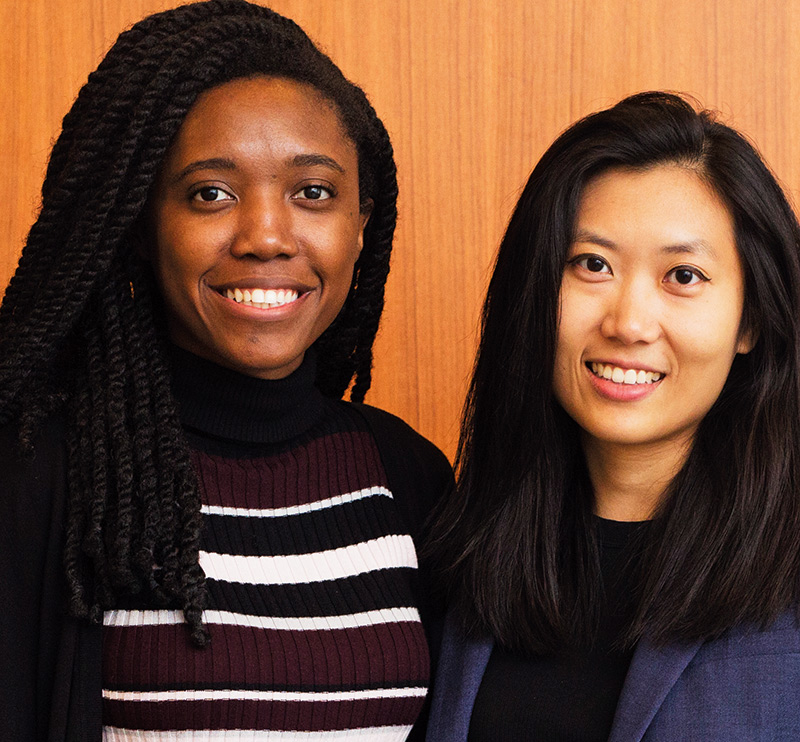
SETTING THE STANDARD Asha Owens (M.A. ’18) and Rebecca Kwee (M.A. ’18) set the standard for practical application with BestFit, which won the inaugural INA Showcase in 2017 and is now on the market. (Photo: TC Archives)
The BestFit app has earned honors in additional prestigious technology competitions and drawn funding from several sources, including the Bill & Melinda Gates Foundation. And hypepotamus also reports that BestFit has responded to the COVID pandemic by launching a resource platform where college students can easily find and apply for free and affordable assistance in their own communities. The online portal provides comprehensive and up-to-date information for students displaced by campus closures. Students can use the platform to find verified local and national resources for food, healthcare, transportation, financial assistance, and other basic needs. They can also find out their eligibility, determine next steps, submit their own resources, and sign up for weekly updates.
BestFit is now headquartered within the Atlanta-based Techstars Social Impact Accelerator.
